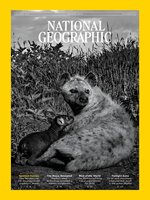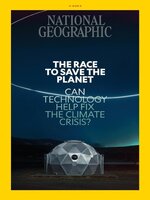Amazing discoveries and experiences await you in every issue of National Geographic magazine. The latest news in science, exploration, and culture will open your eyes to the world’s many wonders.
One Nation, Under Heat and Shade
HOW HAIR PROCLAIMS CULTURE • LOOKING AT THE EARTH FROM EVERY POSSIBLE ANGLE
THE BACKSTORY • PHOTOGRAPHERS CELEBRATE THE CULTURE AND HISTORY WOVEN INTO NIGERIA’S COM PLEX HAIRSTYLES.
‘Honoring’ Health Care’s Bad Actors • THIS GROUP PRESENTS AWARDS FOR PRICE GOUGING, ETHICAL LAPSES, WASTEFUL PRACTICES, DYSFUNCTION — AND WISHES IT DIDN’T HAVE TO.
‘And the Shkreli Award Goes To…’
DISPATCHES FROM THE FRONT LINES OF SCIENCE AND INNOVATION
Deep down, sharks glow in the dark
SEEDLINGS NEEDED TO HIT 2030 GOAL
AIMING HIGH • In the Austrian Alps, climbers seek mountain highs and ascend the ‘Stairway to Heaven.’
VIRAL SPILLOVER
CONNECTED, INFECTED • Spillover risk is highest in abundant, domesticated animals or in common wildlife species that have adapted to human environments. This research was conducted before the COVID-19 pandemic, but experts suspect that SARS-CoV-2 originated in an animal before jumping to humans. All the zoonotic viruses below have caused at least one outbreak among humans. Outbreaks are often underreported.
PLANET POSSIBLE • Enjoying the outdoors shouldn’t imperil the Earth. Give Mother Nature a summer break with easyon-the-environment ideas.
CHANGES IN CHINATOWN • ROOTED IN BOTH RACISM AND MARKETING, THESE HISTORIC ENCLAVES GRAPPLE WITH UNCERTAIN FUTURES.
Unexpected Twists • THEY SET OUT TO TRACK GREAT WHITE SHARKS. BUT WHEN THE TABLES WERE TURNED, A PHOTOGRAPHER’S SURPRISING PICTURE INSPIRED DIGITAL FAKES—AND REAL AWARENESS.
FEATURES
TOO HOT TO LIVE • Rising heat in the 21st century is likely to push millions of people and entire regions out of their comfort zones.
THE HIGH PRICE OF HEAT • Rising heat will kill more people by 2050, but people will also adapt. Researchers at the Climate Impact Lab projected future “mortality costs,” reflecting both the economic value of lives lost and the expense of adaptations such as air-conditioning. Geography, age distribution, and income all affect the projections. Many rich, colder cities will see net benefits. But most of the world’s population, in hot cities without the means to adapt, will see “costs”—and deaths—rise.
HOW THE BODY HANDLES HEAT • Maintaining a constant internal temperature of about 98.6°F is a balancing act. Muscles and organs generate heat that is shed through the skin. But the body also absorbs heat from the environment. A warming climate is exposing almost a third of the world’s population to potentially deadly heat.
A SHADY DIVIDE • In sunny Los Angeles, a lack of tree cover in low-income areas has left many residents especially vulnerable to rising heat. It’s a legacy of the city’s design—and its history of racist policies.
HOW DISCRIMINATION SHAPED LOS ANGELES
L.A.’S TREE CANOPY REFLECTS URBAN INEQUITY
AN URBAN CANOPY CAN HELP COOL A CITY
BUT SHADE CAN BE HARD TO FIND IN MUCH OF L.A.
THE WORLD’S HIGHEST GOLD RUSH • IN THE PERUVIAN ANDES, DESPERATION FUELS A DANGEROUS, TOXIC HUNT FOR THE PRECIOUS METAL.
THIN AIR, DANGEROUS TERRAIN
Conservation That Lasts • Without fenced-off reserves, can wildlife and nearby communities both thrive? In northern Kenya, the pandemic put the idea to the test.
Resilient conservation
THE PRICELESS FOSSILS IN THE GARBAGE DUMP • As a landfill expands in Spain, paleontologists are uncovering many ancient species, including some that were the precursors to apes—and us.
BURIED IN HISTORY
TREVOR BECK FROST • FROM OUR PHOTOGRAPHERS

 Mar 01 2025
Mar 01 2025
 Feb 01 2025
Feb 01 2025
 Jan 01 2025
Jan 01 2025
 Dec 01 2024
Dec 01 2024
 Nov 01 2024
Nov 01 2024
 Oct 01 2024
Oct 01 2024
 Sep 01 2024
Sep 01 2024
 Aug 01 2024
Aug 01 2024
 Jul 01 2024
Jul 01 2024
 Jun 01 2024
Jun 01 2024
 May 01 2024
May 01 2024
 Apr 01 2024
Apr 01 2024
 Mar 01 2024
Mar 01 2024
 Feb 01 2024
Feb 01 2024
 Jan 01 2024
Jan 01 2024
 Dec 01 2023
Dec 01 2023
 Nov 01 2023
Nov 01 2023
 Oct 01 2023
Oct 01 2023
 Sep 01 2023
Sep 01 2023
 Aug 01 2023
Aug 01 2023
 Jul 01 2023
Jul 01 2023
 Jun 01 2023
Jun 01 2023
 May 01 2023
May 01 2023
 Apr 01 2023
Apr 01 2023
